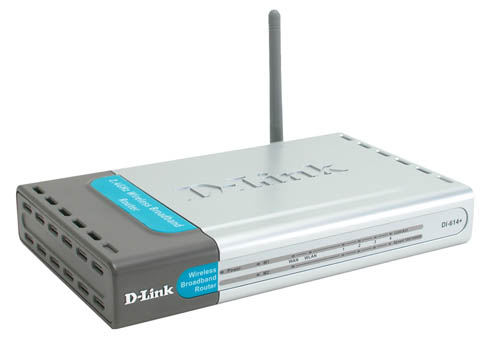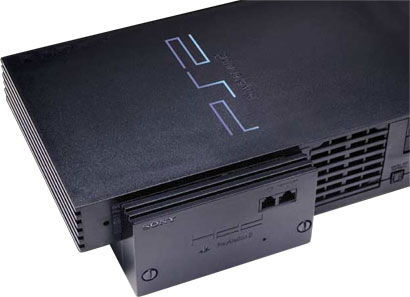Get Your Console Online
This primer will show you the basics of how to get your console connected and ready for online play.
Design by Collin Oguro
Games are best played with (and against) other people, and gamers with a broadband connection need to consider connecting their consoles to the Internet. Whether you're starting from scratch or already have an existing home network, getting connected is a snap as long as you know what extra hardware and software is required.
Network Hardware
Firstly, if you don't have a broadband Internet connection, forget it. A dial-up connection does a terrible job of handling a console's demands, and most services, software, and hardware require a broadband connection. There are exceptions, like some PlayStation 2 games that support dial-up multiplayer, but you'll have a much smoother experience with a broadband connection.
It's possible to connect a console directly to a broadband modem, but since you'll probably want to share access between all of the computers and consoles you own, we recommend setting up a basic home network. At minimum you'll need a router, which handles network traffic and lets any connected device access the network at any time. There are two basic choices to consider with routers--wired or wireless--and you also should look for one that has enough ports to handle all of the devices you plan to include on the network. Wired routers are very cheap but require that all devices connect directly to the router using Ethernet cables. Wireless routers are much more versatile, since they offer wired connection ports and are compatible out of the box with Wi-Fi-enabled devices like the Sony PSP and Nintendo DS.

We recommend you go with a wireless router that supports 802.11b (often called Wi-Fi) and 802.11g for maximum compatibility. 802.11b is the older, slower, and more ubiquitous standard that nearly every wireless device is compatible with. 802.11g is much faster and transmits on the same frequencies as 802.11b, so the same router can easily support both standards. The only other common option right now is 802.11a, which is also much faster than 802.11b, but it operates at a much higher frequency and is therefore usually only found in more expensive routers. It also has a shorter range than either 802.11b or 802.11g and is not supported by many devices, including current consoles.
For the fastest and most reliable connection, use an Ethernet cable connected directly between the console and a broadband modem or router. This isn't always practical, but it is by far the cheapest and best way to enjoy console games online.
Going wireless requires some additional hardware. It's unfortunate, but none of the current console systems support Wireless NICs (Network Interface Cards). These cards are the cheapest way to get connected to a wireless network, but this type of hardware is unfortunately not supported by any current console. Connecting an Xbox, PS2, or GameCube wirelessly instead requires the use of a bridge. Bridges don't require any special drivers or support--they basically operate as a "cordless cord," making the device they are attached to think it is connected directly to the router. You'll need to connect the bridge directly to the router for initial configuration, but once that is complete it should work with any network-enabled device.

Those who want to go wireless, but don't want to use a wireless router have a few other options, albeit with some compromises that will need to be made. Nyko, for example, sells a Wireless Net Extender, and Logitech offers a wireless Play Link. Both of these products use proprietary technology to transmit a wireless signal, and much like bridges, they fool a device into thinking it is hooked directly to a router. The devices we've tested all transmit in the 900MHz frequency range, and are therefore prone to interference from cordless phones, baby monitors, and other devices sharing the same slice of the radio spectrum. They also operate at about one-tenth the maximum speed of an 802.11b wireless Ethernet bridge, making downloads relatively slow. But they still work just fine for the vast majority of gaming tasks where reliability and less lag are far more important than raw throughput. These types of products are also very easy to install, but are pricey compared to a wireless bridge.
Now that the basic equipment is taken care of, you just need to worry about the specific hardware required to get your consoles online.
Xbox

The Xbox is Ethernet-ready out of the box. You can connect an Ethernet cable to it directly to access the Internet, or you can use a wireless bridge or proprietary wireless solution. Microsoft sells its own bridge, which is configurable directly through the Xbox Dashboard, making it a decent option for Xbox owners who don't have a computer to perform the initial setup. If you do have a computer, you can save a lot of money by purchasing a cheaper third-party bridge.
The best way to game online with the Xbox is via Microsoft's excellent Xbox Live service. Most Live-enabled games come with a free two-month trial pass, but to maintain a unique gamertag, cumulative stats, and other aspects of the service requires a subscription of $49.99 per year or $5.99 per month. While matchmaking and other options vary from game to game, the overall service is outstanding, and it also lets you download patches and extra content for certain games that aren't available anywhere else. We recommend you purchase either an Xbox Live kit that comes with a headset or buy a third-party headset to get the most out of the service.

Xbox Live may be the best and most popular way to play online, but there are some alternatives that let players set up a virtual system-link setup to play all of the multiplayer games that support that mode but that don't necessarily support Live (Halo, we're looking at you). Try the free version of XBConnect (www.xbconnect.com), and if you like it, consider buying the $14.95 Pro version that offers many more features. You'll need a computer to benefit from XBConnect, but it does provide cash-strapped gamers with a viable alternative to Live.
Finally, if you installed a mod chip in your Xbox, here's hoping you can disable it temporarily when you go online. Xbox Live can detect whether or not your system is modded and permanently boot you, so you'll need a mod chip with an on/off switch or an entirely separate Xbox for online play.
PlayStation 2

Connecting an older PlayStation 2 to a network requires purchasing the separate network adapter, which attaches to the back of the console using screws. The newer, sleeker 70000-series units have integrated Ethernet adapters, so the only other equipment you'll need is a cable or wireless bridge. A PS2-compatible USB headset is also recommended, but isn't absolutely necessary. If you play online RPGs that require a lot of typing, several companies also offer controllers with built-in keyboards, along with stand-alone USB keyboards that are PS2-compatible.
Online support is offered on a game-by-game basis, and there is no overarching service like Live to help in keeping track of friends. Sony does maintain a list of all games that support online multiplayer at www.us.playstation.com/onlinegaming. This site also has specific information for any router or other settings you'll need to adjust to get each game to work, if necessary.
GameCube

Getting a GameCube online isn't worth the expense for most people, but it's still possible by purchasing Nintendo's broadband adapter. This difficult-to-find accessory snaps into the bottom of the unit, and then you can connect the GameCube using either an Ethernet cable or a wireless bridge.
The only online-enabled game for the GameCube right now is Phantasy Star Online, which requires a monthly subscription fee. But a little piece of software called Warp Pipe (cubeonline.warppipe.com) will let you play any LAN-enabled game through the Internet. Sadly, these currently are limited to Kirby Air Ride, 1080 Avalanche, and Mario Kart: Double Dash!!.
The Nintendo DS and Sony PSP
All you need to play online games with your Nintendo DS or PSP is access to a wireless network. Both of these handhelds have integrated 802.11b transceivers, so you're set.
The Future of Online Console Games
When the next generation of consoles is upon us, getting them connected to the Internet should be much easier. Microsoft, Nintendo, and Sony have each announced that their next consoles will have Ethernet ports integrated into the design. The Xbox 360 will be 802.11b- and 802.11g-ready, meaning it will be easy to plug a compatible NIC into the device and game away. Nintendo has claimed that its Revolution will have Wi-Fi built in, and Sony has made the same claim about its PlayStation 3. Of course, all of these specifications are subject to change, but the bottom line is that you'll need broadband access and a home network--wireless or otherwise--to get the most out of future console games.
Got a news tip or want to contact us directly? Email news@gamespot.com
Join the conversation